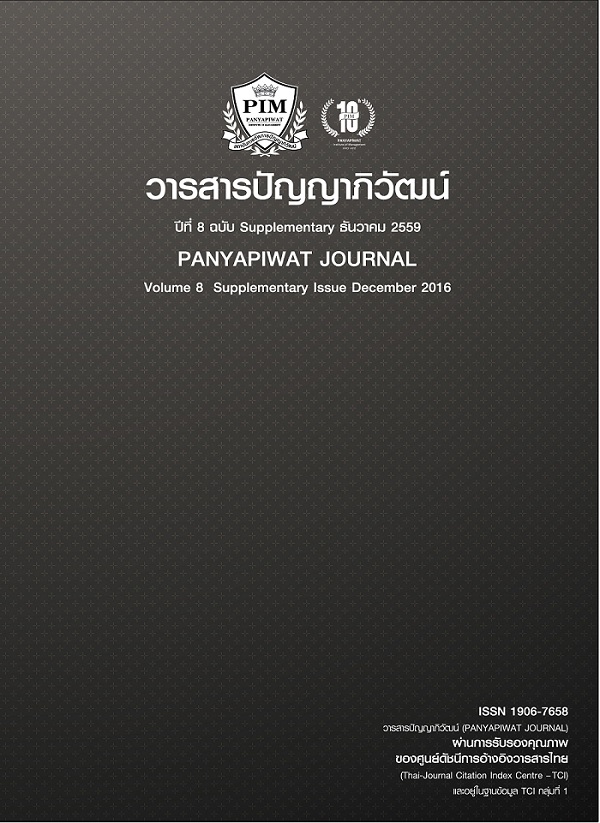INVESTIGATING JOB SATISFACTION IN SERVICE INDUSTRY
Main Article Content
บทคัดย่อ
The purpose of this paper is through ‘document research’ to analyze 80 articles about job satisfaction in service industry or have relationship with service industry, to uncover current research situation and development trend about job satisfaction in service industry.
The major finding from this study is through analyze 80 articles’ samples and sizes, researcher finds that primary industry is Health-Care and secondary industry is Education, because both of two industries covered 70 articles in researcher’s articles; almost all articles choose quantitative research method as major research method in their studies. This researcher finds that investigation of job satisfaction in Health-Care industry focuses on three roles. The primary role is doctors because nearly all articles choose hospital as research setting, the secondary role is nurse because this role still important in hospitals. Tertiary role is choosing all staffs of hospital as research sample. Researcher still finds that investigation of job satisfaction in Education industry focus on two roles. The primary role is teacher. The secondary role is to choose non-teaching employees from setting as the research sample. Researcher finds that almost 70 articles have the same point in their findings: factors that affect job satisfaction. At last, researcher focuses on this point of view to distinguish similar and difference between health-care and education.
Article Details
“ข้าพเจ้าและผู้เขียนร่วม (ถ้ามี) ขอรับรองว่า บทความที่เสนอมานี้ยังไม่เคยได้รับการตีพิมพ์และไม่ได้อยู่ระหว่างกระบวนการพิจารณาลงตีพิมพ์ในวารสารหรือแหล่งเผยแพร่อื่นใด ข้าพเจ้าและผู้เขียนร่วมยอมรับหลักเกณฑ์การพิจารณาต้นฉบับ ทั้งยินยอมให้กองบรรณาธิการมีสิทธิ์พิจารณาและตรวจแก้ต้นฉบับได้ตามที่เห็นสมควร พร้อมนี้ขอมอบลิขสิทธิ์บทความที่ได้รับการตีพิมพ์ให้แก่สถาบันการจัดการปัญญาภิวัฒน์หากมีการฟ้องร้องเรื่องการละเมิดลิขสิทธิ์เกี่ยวกับภาพ กราฟ ข้อความส่วนใดส่วนหนึ่งและ/หรือข้อคิดเห็นที่ปรากฏในบทความข้าพเจ้าและผู้เขียนร่วมยินยอมรับผิดชอบแต่เพียงฝ่ายเดียว”
เอกสารอ้างอิง
Ahsan, N., Abdullah, Z., Gun Fie, D. Y. & Alam, S. S. (2009). A Study of Job Satisfaction among University staff in Malaysia: Empirical study. European Journal of Social Sciences, 8(1), 121-131.
Bai, J. W. (1997). How to Apply Job Satisfaction to Human Resource Management. Human Development Monthly,118, 2-3.
Cai, M. H. (2006). The reconstruction of job satisfaction scale between public and private organization. Master’s thesis, Research institute of Human Resource Management, National Sun Yat-sen University.
Clark, A. E. (1998). Measures of Job satisfaction: What makes a good job? Evidence from OECD countries. Labour Market and Social Policy Occasional Papers, 34, 1-38.
Davis, S. K. L. (2002). Multigenerational perceptions of leader behavior, older employees and job satisfaction in a housing and food services industry in Pennsylvania. Doctoral dissertation, Workforce Education and Development, University of Pennsylvania.
Guo, H. B. (2007). The limits and the initially search of the operation strategy for the modern service firms. Market Modernization, 7, 52–53.
Hoyle, R. H., Harris, M. J. & Judd, C. M. (2002). Research methods in social relations. Singapore: Thomson Learning.
Kudo, Y., Satoh, T., Hosoi, K., Miki, T., Watanabe, M., Kido, S. & Aizawa, Y. (2006). Association between intention to stay on the job and job satisfaction among Japanese nurses in small and medium-sized private hospitals. Journal of Occupation Health, 48(6), 504-513.
Li, C. (2001). High - tech Industry Human Resource Management. Taipei, the world vision.
Li, G. P. (2008). The background, status and trends of employee-satisfaction study. Journal of Henan University of Technology (Social Science), 4(3), 40-42.
Li, H. S. (2004). Discuss job satisfaction in contemporary service industry for young integrate employee. College of Business Administration, Fudan University.
Marwick, I. (1970). Psychiatric nursing in transition. International nursing review, 17(3), 267-286.
McCulloch, G. (2004). Documentary research in education, history and the social sciences. New York: Routledge Falmer.
Qin, W. (2000). Social science research methods. Chengdu: Si Chuan People’s Publishing House.
Robbins, S. P. & Judge, T. A. (2009). Organizational behavior (13th ed.). Upper Saddle River, NJ: Prentice-Hall.
Robbins, S. P. (2005). Organizational behavior (11th ed.). Upper Saddle River, NJ: Prentice-Hall.
Shi, K. (2001). The structure of job satisfaction and the relationship with perceived fairness and turnover intention. Chinese Human Resource Development, 1(127), 15-17.
Spector, P. E. (1997). Job satisfaction: Application, assessment, causes, and consequences. Thousand Oaks, CA.: Sage.
Torressen, M. A. (2000). A study to examine perceived role ambiguity, role conflict, participation in decision making, ability and job satisfaction among intellectual property licensing professionals. Doctoral dissertation, School of Education, New York University.
Wang, S. Y. (2003). Review of the Theoretical Evolution of Western Teriary Industry. Social Sciences in Human, 5, 85-88.
Whisenant, W. & Smucker, M. (2009). Organizational justice and job satisfaction in coaching. Public Organization Review, 9, 157-167.


